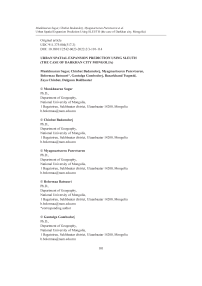Urban spatial expansion prediction using Sleuth (the case of Darkhan city, Mongolia)
Автор: Munkhnaran Sugar, Chinbat Badamdorj, Myagmartseren Purevtseren, Bolormaa Batsuuri, Gantulga Gombodorj, Bazarkhand Tsegmid, Zaya Chinbat, Dulguun Boldbaatar
Журнал: Природа Внутренней Азии @nature-inner-asia
Рубрика: География
Статья в выпуске: 2-3 (21), 2022 года.
Бесплатный доступ
The aim of this study is to simulate the urban sprawl of Darkhan city and to predict future urban expansion using the SLEUTH CA model. The model performs mathematical calculations based on the historical change in urban growth from the past to the present and models future trends using 8 expansion indices and 5 coefficients.The spatial expansion of Darkhan city is expected to increase steadily by 1%, and the rate of expansion is expected to decline between 2035 and 2040 due to the impact of land resources and constraints. The SLEUTH model presented an edge growth that accounts for about 95% of the total expansion.
Urban sprawl, urban spatial expansion, simulation, prediction
Короткий адрес: https://sciup.org/148325683
IDR: 148325683 | УДК: 911.375:004(517.3) | DOI: 10.18101/2542-0623-2022-2/3-101-114
Текст научной статьи Urban spatial expansion prediction using Sleuth (the case of Darkhan city, Mongolia)
Globally, one of the challenges facing cities, large and small, in both developed and developing countries is urban spatial expansion. Some of their spatial patterns are interpreted as urban sprawl [Quezada et al. 2009]. Urban sprawl is a consequence of socio-economic development under certain conditions. It includes low residential density, leapfrog, scattered suburban linear patterns, and dependence on private transport [Batty, 2005].
The term “urban sprawl” refers to the type of land use directed to the suburbs, planned or unplanned, inefficient, dependent on private transportation, covering a large area of suburban agricultural land, and low density. In other words, urban sprawl is a phenomenon that affects a large area outside the city and the rapid infiltration of residential and non-residential development into relatively pristine nature [Burchell & Galley, 2003;
Urban sprawl is manifested through changes in land use, such as the conversion and construction of suburban agricultural lands, forests, and reservoirs for residential and non-residential use, and land-use change models are mainly used to model urban sprawl. Changes in land use are then defined as an increase or decrease in the area covered by a particular type of land use [Briassoulis, 2000].
Scientists have developed many models of urban land-use change and urban expansion simulation regarding the future consequences for land use. According to Ryu, in 1973, Marilyn divided the urban model into three categories: a) urban development, b) transportation, and c) urban development [Rui, 2013]. Briassoulis [2000] classified land-use change models as statistically, econometrically, spatially correlated, optimization, integrated, natural science level, Geographic Information System (GIS), and Markov chain-based models.
Many different models and algorithms have been developed to model urban sprawl such as Cellular Automata (CA) coupling with fuzzy logic, artificial neural network, Markov-chain with genetic algorithm [Tang et al. 2007], SLEUTH [Clarke et al., 1997] and many others [Batty, 2005]. Amongst all, cellular automata models have proved rather popular for modelling and simulating the physical growth of cities [Bihamta et al., 2015].
Since CA model grids have a structure similar to GIS raster data, they can be used in combination with remote sensing and raster data from other sources. CA is widely used in geography and other related fields due to its advantages, such as it is possible to connect to GIS, dynamic, micro-modelling, and bottom-up approaches. In terms of application, CA models have been used for urban land-use change, urban models, modelling urban forms, urban and regional development planning, and many other urban studies [Clarke et al., 1997, Clarke and Gaydos, 1998]. In recent years, new CA models, such as URBANISM, UPLAN, SLEUTH have been used for forest future changes, trends of development, and simulating urban spatial expansion.
Clarke et al. [1997] introduced SLEUTH model for simulating urban historic change and predicting future urban growth.The SLEUTH model has been used extensively in recent yearsin geographical modelling for planning design [Clarke et al., 1997; Clarke & Gaydos, 1998] and land-use change studies [Clarke et al., 1997; Jantz et al., 2009, Silva & Clarke, 2002; Oguz et al., 2007; Onstead & Clarke, 2011; Xian, 2005], and it is possible to visualize and quantify the results of the model, which is statistically accurate and credible. Urban land cover can only be used in two general categories: urban and non-urban, and it can be used to map urban growth and land-use changes using the latest data, as well as to model predictions.
This paper uses the CA model of SLEUTH which is an acronym for the spatial datasets required as input data such as slope, land cover, exclusion, urban extent, transportation, and hillshade. SLEUTH is based on cellular automata and uses a combination of two models of Urban Growth Model (UGM) and the Land Cover Deltatron Model (LCDM) and can be used separately. It is a model that places grids in chronological order to study the state of change, determine whether the transition from undeveloped land to a developed one is taking place [Clarke et al. 1997], and predict future urban growth projections based on that changing trend.
Materials and Methods
Study area
Darkhan is the second biggest city in Mongolia, located in Darkhan-Uul province (Figure 1). The foundation of Darkhan city was laid on October 17, 1961, with the establishment of the Darkhan railway station. The population of Darkhan fell to its lowest at 64,573 in 1995 because 7,000 Soviet citizens returned home, many Kazakhs migrated to Kazakhstan, and the working class relocated to the countryside and the capital city after the closure of large factories. However, the population of Darkhan has been growing steadily for the last 20 years at an average rate of 1 percent annually from previous years, reaching 107,751 in 2019 [NSO, 2021]. According to the “Darkhan City Development Master Plan until 2030”, the population of Darkhan is expected to reach 130,000 by 2035. Due to the population growth, the residential areas have expanded significantly, with many patterns of land use accompanying them and facing the challenges that many cities faced during their growth.
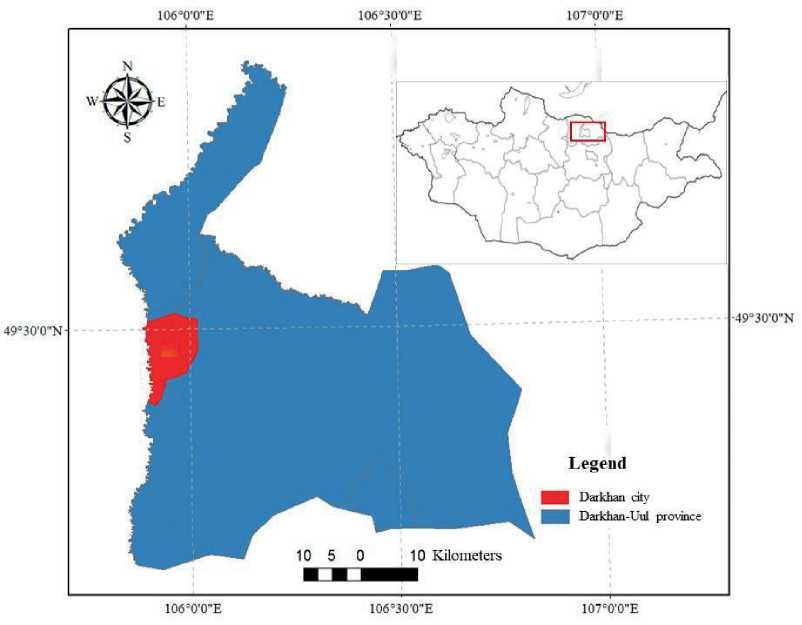
Figure 1. Darkhan city
SLEUTH model
In this study, the SLEUTH model is used to simulate urban sprawl. The SLEUTH model is an open-source package developed by Clarke, based on CA model, which can be applied to city development simulation in metropolitan areas [Clarke et al. 1997]. SLEUTH was written in C programming language.Cygwin, a compiler, was used to run code with C extensions. Cygwin allows usingof GNU and Open-source packages on Windows operating systems. Visual Studio Code was used to edit the C source code for SLEUTH grid automated programming.The image format used during the calibration phase was performed using GIMP 2.0.The SLEUTH model was performed in three modes (Figure 2).

Figure 2. Modes of SLEUTH modelling
Preparation of input
To simulate urban sprawl and predict the urban growth of Darkhan, input data of slope, land cover, exclusion, urban extend, transportation, and hillshade were obtained from satellite images based on supervised classification.
Second, the collected data is polished and converted to the format required for use in the model. SLEUTH-style raster images were converted to formats such as spatial accuracy (20m), area size, geographic projection (WGS_1984_UTM_Zone_48S), data format (GIF), and data type (8 bit).
Third, the data must be standardized or named in accordance with the format specified in the SLEUTH C programming language code.
The main part of the research was performed on the SLEUTH-CYGWIN converter software, and the input data used to develop the SLEUTH model consisted of 6 types of cellular raster imagesfor 20 years from 2000 to 2020, which were used as layers (Table 1). The input data were prepared and analyzed using Arcgis 10.8, Envi 5.3, R and Visual Studio Code.
Table 1
Input data set, sources
|
Input layer |
Source |
Format and year |
|
Slope |
DEM 12.5m |
Raster |
|
Land use |
Classified from satellite data |
Raster 2000, 2010, 2020 |
|
Excluded |
On screen digitization |
Rasterized from vector |
|
Urban Extent |
Classified from satellite data |
Raster 2000, 2010, 2020 |
|
Transportation |
Digitized on SAS Planet image |
Raster 2000, 2010, 2020 |
|
Hillshade |
DEM 12.5m |
Raster |
a
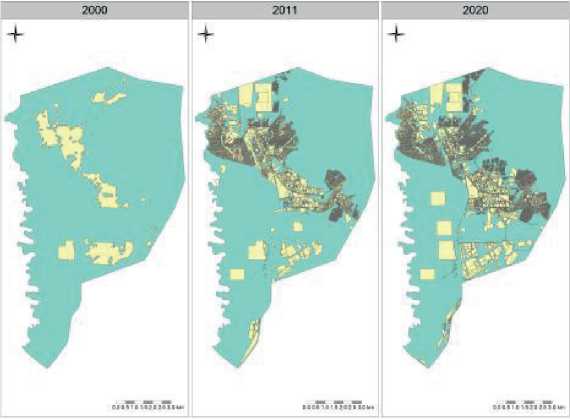
b
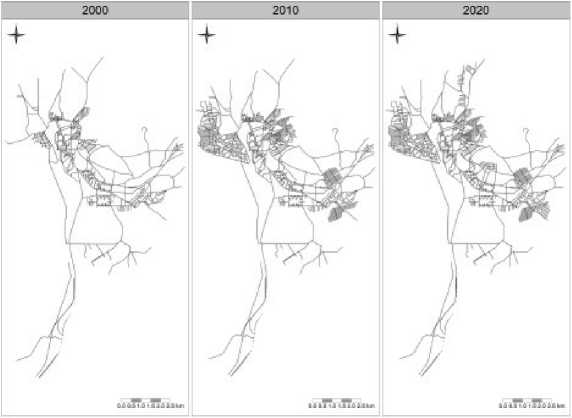
Figure 3. Input data: a. Urban extent b. Transportation
Slope and hillshade layers were extracted from 12.5 DEM and calculated using terrainfunction and hillShade function of R software rastertoolset respectively. The Urban Extent images were classified using the supervised classification method from Landsat5 satellite data of 2000, 2010 and 2020 (Figure 3a). Transportation layers resulted from on-screen digitization of high-resolution satellite images from SAS planet (Figure 3b). The excluded layer consists of forest, surface water, special needs land, landfill, and cemetery.
Calibration
Code testing
The source code for the C programming language, developed and edited using Visual Studio Code, worked without any errors when the code was tested using test images from the SLEUTH3.0beta_p01_linux_tar package.
Calibration
SLEUTH is a modified CA model in which five coefficients (diffusion, breed, spread, slope, and road) control four types of rules (spontaneous growth, new spreading center growth, edge growth, and gravity growth) [Clarke, 1997]. During the calibration, coefficients are responsible to detect the form of urban growth via above mentioned four rules. SLEUTH model utilizes Monte Carlo iteration to generate multiple simulations of urban growth. Therefore, parameters are standardized in a range between 0 to 100 that reflects the relative contribution of each parameter to the dynamic of urban growth. And calibration processes are divided into three phases (coarse, fine, and final) in each phase the parameter space is extensively explored through a sequential number of Monte Carlo iterations and possible combinations of coefficients. Three phases of calibration and the most appropriate coefficients to predict future urban growth are given in the table below (Table 2).
Table 2
Coefficients for the calibration phases
|
Coarse |
Fine |
Final |
Prediction |
|||||
|
Value |
Steps |
Value |
Steps |
Value |
Steps |
Value |
Steps |
|
|
Diffusion |
0–100 |
25 |
0–20 |
5 |
23–27 |
1 |
25 |
1 |
|
Breed |
0–100 |
25 |
0–25 |
5 |
23–27 |
1 |
23 |
1 |
|
Spread |
0–100 |
25 |
25–50 |
5 |
47–52 |
1 |
52 |
1 |
|
Slope |
0–100 |
25 |
0–25 |
5 |
0–5 |
1 |
1 |
1 |
|
Road |
0–100 |
25 |
50–100 |
5 |
80–100 |
5 |
85 |
1 |
|
Monte Carlo iteration |
5 |
7 |
10 |
100 |
||||
|
Total iteration |
3124 |
7775 |
4499 |
--- |
||||
The coefficients get refined from their widest range in the coarse phase leading to a narrower range in the next calibration phases including the fine and final stages. The sensitivity of the model can be addressed by incrementing the parameters through steps during the calibration.
Coarse calibration
At this stage, the range of the coefficients is 0-100, and the ascent step is taken as 25. When the number of iterations of Monta Carlo is given by 5, the total number of iterations is 3124. The ability to re-model the historical expansion of the input data time was assessed using the Lee-Sallee Index and the Comparative Index. The Lee-Sallee index is a model of historical data [Dietzel, 2006]. A Lee-Sallee index of 0.54 or higher is considered appropriate for the object of study [Silva, 2002]. The comparative index is an index that shows the correlation between the “original set” (number of city pixels) and the urbanization of the control years. The Lee-Sallee index of the coarse calibration was 0.74 and the comparative index was 0.992 (Figure 4).
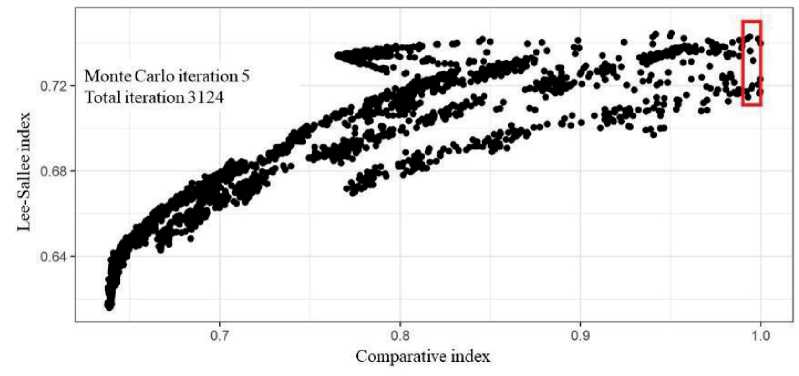
Figure 4. Lee-Sallee index and Comparative index of coarse calibration
Fine calibration
The coefficient ranges were decreased to 5 and the Monte Carlo iteration was increased to 7. As the result, the total iteration number increased to 7775. Lee-Salleeindex was 0.73, the comparative index was 0.93 (Figure 5).
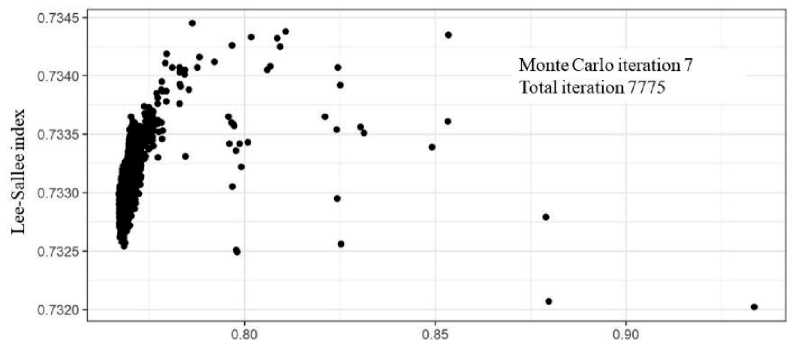
Comparative index
Figure 5. Lee-Sallee index and Comparative index of Fine Calibration
Final
.
ient1rangesіwere dec
Total itiВratic ) ttl S I
x n> 73395
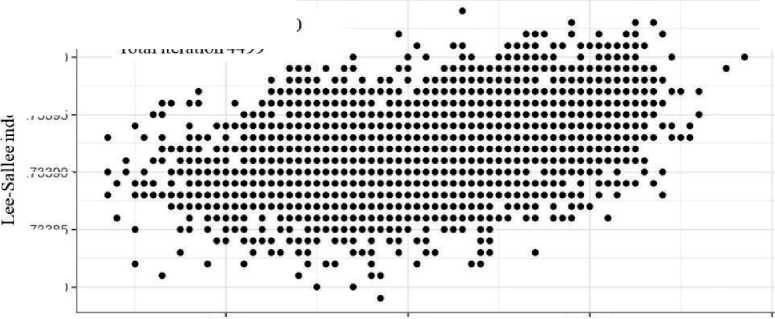
/3390 -
0.73380
0.7703
0.7707
0.770
0.7705
Comparative index
Figure 6. Lee-Salleeindex and Comparative Index of Final Calibration
Result
Validation and modelling results were carried out by predicting urban spatial growth from 2000 to 2020. The Lee-Sallee index of the final test was 0.73 and the comparative index was 0.93, so the values from the final calibration were used to predict the future urban growth of Darkhan for 2020–2040. The number of Monta Carlo repetitions is 100. The five coefficient values that were obtained in the calibration process were used to predict urban spatial expansion. Coefficients values to predict the future urban growth pattern are shown in Table 3. The spatial expansion patterns indicate a very high value of road gravity and spread.
Table 3
Coefficient Values to determine the urban expansion pattern
|
Diffusion |
Bread |
Spread |
Slope |
Road gravity |
|
25 |
23 |
52 |
1 |
85 |
As shown in the figure below, the spatial expansion of Darkhan is expected to increase steadily by 1%, and the rate of expansion is expected to decline between 2035 and 2040 (Figure 7a). The model is based on the principle of self-modification of the coefficients to determine the growth of the following year so that as the values of the coefficients decrease, the rate of urban expansion decreases (Figure b).
The probability of expansion is zero where urban growth is restricted which is defined in the excluded layers. As shown in Figure 8 urban growth probability is higher were closer to the current area of the city.
As can be seen from Figure 9, the size of the expansion in Darkhan is declining year by year, and from 2035 onwards, the expansion is expected to decrease sharply. In terms of the type of expansion, approximately 95% of the total expansion is the peripheral expansion.

Figure 7 . Future Urban Growth Trend between 2020–2040 a. Urban growth by area, b. Coefficients to determine the growth
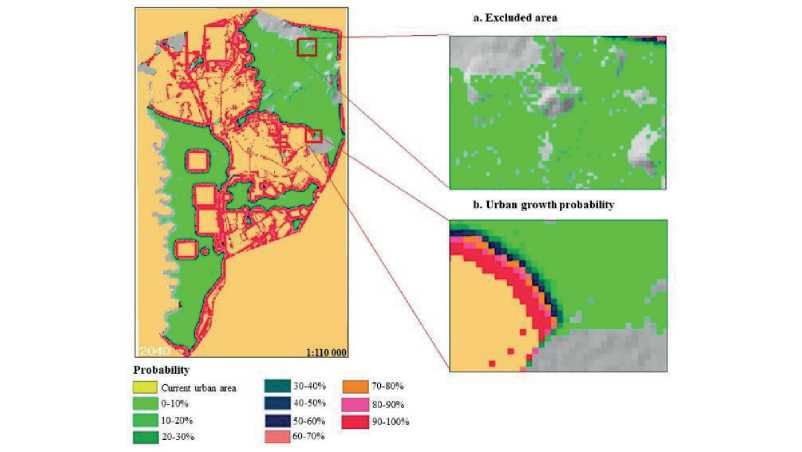
Figure 8. Prediction of Urban Growth in Darkhan (2020–2040)
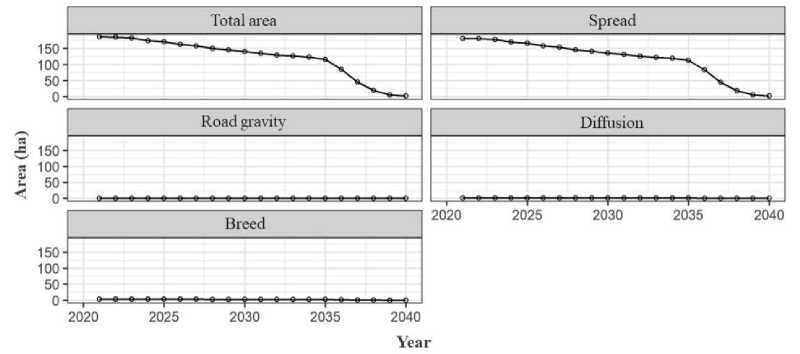
Figure 9. Predicted Urban Growth Pattern
Discussion
-
• When editing open-source code in the SLEUTH model, the source code errors, data errors, and user system errors can occur. As there are many source code errors in the C programming language, we need to ensure that there are no domino effects during the editing process. The error provided by the terminal is to be checked if it is related to the data or the misspelt source code. Lastly, errors that are not associated with data or source code are errors that are related to the user’s system.
-
• The model can be further improved as the accuracy of the output data and survey results depend on the accuracy of the input data. Calculating the pixel ratio of the input image as small as possible depending on the scale will increase the model’s predictability.
-
• This model can be used and developed depending on the study area’s specifics. The model can be improved by using additional social, economic, and physical geography layers to estimate the city’s future expansion.
Conclusion
The SLEUTH model, which has been used around the world in recent years, predicts the future urban expansion of Darkhan city in 2020–2040.
The spatial expansion of Darkhan city is expected to increase steadily by 1%, and the rate of expansion is expected to decline between 2035 and 2040 due to the impact of land resources and constraints. The SLEUTH model presented an edge grow that accounts for about 95% of the total expansion.
The SLEUTH model is one of the models extensively used in growth modeling. SLEUTH model showed the convincing and statistically accur results sult. In addition, the time sensitivity of the SLEUTH model was more suitable for developing shortterm projections using recent data than for making long-term forecasts using longterm historical data. Studies by Dietzel and Clarke have also shown that more detailed, hierarchical land use subclasses are more effective in terms of primary or general land use classifications. However, no studies have shown that this model is more effective in determining both land-use change and urban growth.
Список литературы Urban spatial expansion prediction using Sleuth (the case of Darkhan city, Mongolia)
- Batty M. (2005). Cities and Complexity: Understanding Cities with Cellular Automata, Agent-Based Models, and Fractals. Cambridge: England.
- Bihamta N., Soffianian A., Fakheran S., & Gholamalifard M. (2014). Using the SLEUTH Urban Growth Model to Simulate Future Urban Expansion of the Isfahan Metropolitan Area, Iran. J Indian Soc Remote Sens. doi:10.1007/s12524-014-0402-8
- Burchell R., & Galley C. (2003). Projecting Incidence and Costs of Sprawl in the United States. Transportation Research Record.
- Briassoulis, H. (2000). Analysis of Land Use Change: Theoretical and Modeling Approaches. PhD Thesis in Geography. Levos, Greece: University of Aegean.
- Clarke K., & Gaydos L. (1998). Loose-Coupling a Cellular Automaton Model and GIS: Long-Term Urban Growth Prediction for San Francisco and Washington/Baltimore. International Journal of Geographical Information Science, 12(7): 699-714.
- Clarke K., Hoppen S., & Gaydos L. (1997). A Slef-Modifying Cellular Automaton Model of Historical Urbanization in the San Francisco Bay area. Environment and Planning B: Planning and Design, 24(2): 7-14.
- Ewing R. (1997). Is Los Angelos-style sprawl desirable? Journal of the American Planning Association, 63(1): 107-126.
- Grimm N., Grove J., Pickett S., & Redman C. (2000). Integrated Approaches to Longterm Studies of Urban Ecological Systems. Bioscience, 50: 571-584.
- Hasse J., & Lathrop R. (2003). Land Resources Impact of Urban Sprawl. Applied Geography, 23: 159-175.
- Jantz C., Goetz S., Donato D., & Claggett P. (2009). Designing and Implementing a Regional Urban Modelling System Using the SLEUTH Cellular Urban Model. Computer, Environment and Urban System, 34: 1-16.
- Oguz H., Klein A., & Srinivasan R. (2007). Using the Sleuth Urban Growth Model to Simulate the Impacts of Future Policy Scenarios on Urban Land Use in the Houston-Galveston-Brazoria CMSA. Research Journal of Social Sciences, 1: 72-82.
- Queslati, W., Alvanides, S., & Garrod, G. (2015). Determinanats of urban sprawl in European cities. Urban Studies, 52(9), 1594-1614.
- Quezada R. C., Olivera M. I., & Vilalta J. P. (2009). Cartography and Spatial Analysis of Urban Sprawl. 24th International Cartographic Conference.
- Rui Y. (2013). Urban Growth Modeling Based on Land-use Changes and Road Network Expansion. Stockolm, Sweden: Royal Institute of Technology.
- Onstead J., & Clarke K. (2011). Forecasting Enrollment in Differential Assessment Programs Using Cellular Automata. Environment and Planning B: Planning and Design, 38(5): 829-849.
- Sierra Club. (1999). The dark side of the American Dream: The Costs and Consequences of Suburban Sprawl. San Francisco: CA.
- Silva E., & Clarke K. (2002). Calibration of the SLEUTH Urban Growth Model for Lisbon and Porto, Portugal. Computers, Environment & Urban Systems, 26, 525-552.
- Squires G. D. (2002). Urban Sprawl: Causes, Consequences & Policy Responces. Washington DC: The Urban Institute Press.

